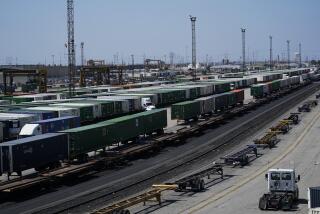Safety Panel OKs Rules on Trailing 757 Jets : Aircraft: Guidelines seek to avert crashes linked to wake turbulence, which apparently downed a plane in Santa Ana in which five people died.
- Share via
WASHINGTON — The National Transportation Safety Board on Tuesday approved a detailed set of recommendations designed to prevent airplane accidents caused by wake turbulence--the presumed cause of a crash that claimed five lives when a twin-engine corporate jet went out of control while landing about two miles behind a Boeing 757 at John Wayne Airport in December.
The board’s action sent a strong message to the Federal Aviation Administration that the minimum distances between landing airplanes should be increased and that its 20-year-old weight classification system for larger aircraft be overhauled to reflect a new generation of commercial jetliners.
The board also urged that air controllers provide more detailed information to pilots about wake turbulence and that training manuals be updated to emphasize the dangers of such airborne encounters, particularly when the trailing plane is smaller and more vulnerable to the miniature cyclones produced by rapid air movement across the larger aircraft’s wings.
Safety board records show that 51 wake turbulence incidents or accidents have occurred over the last decade, killing 27 people and damaging or destroying 40 airplanes.
The FAA has been reluctant to increase separation distances between 757s and trailing aircraft. But only a week after the crash of the corporate jet in Santa Ana two months ago, FAA Administrator David Hinson issued a directive requiring air traffic controllers nationwide to warn pilots of the turbulence caused by 757s.
The safety board’s action Tuesday, although not binding on the FAA, is expected to put more pressure on federal regulators to adopt the preventive procedures adopted unanimously by the board’s five commissioners.
FAA spokesman Paul Steucke said the agency would review the safety board recommendations immediately. “We’re aware of the problem and we’re taking measures to make sure there is not another occurrence,” Steucke said.
Besides the fatal accident in Santa Ana, four other incidents related to 757 turbulence have occurred in the last 14 months, including a Dec. 18, 1992, crash in Billings, Mont., that killed eight people.
Although many of the wake turbulence accidents involve Boeing 757 jetliners, the commissioners did not cite any particular flaw in the airplane’s design. The heart of the problem, they said, is revising the FAA’s plane classification system to ensure the proper separation between airplanes.
“There may be some unique characteristics of the 757,” Commissioner John. K. Lauber said, “. . . but it is clear that the fundamental problem goes back to the outdated weight categorization scheme that needs to be fixed.”
The board found that “inadequacies in the current airplane weight classification scheme . . . air control procedures . . . and pilot knowledge . . . of wake vortices were more important factors in the five recent accidents investigated by the safety board than any specific characteristic of the B-757 wake vortex.”
Under the present system, the 757 is considered a large aircraft, but industry experts have previously urged the FAA to reclassify it as a heavy aircraft and require smaller planes to stay farther behind.
The board took action on both fronts Tuesday. It recommended that the separation distances be lengthened for smaller planes trailing 757s--even for jetliners such as Boeing 737s, MD-80s and DC-9s.
And it also urged that the three-tiered U.S. airplane weight classification system be revised to narrow the weight ranges in some categories. Under present U.S. rules, the 757 is the heaviest aircraft in the middle weight class.
The commission also recommended that 757s and other large aircraft conduct landings on a more standard flight path angle. The board’s study of wake turbulence incidents showed that trailing airplanes are in more danger of being thrown out of control when they are below the larger plane’s descending flight path.
Because 757s and other newer jets can slow down more quickly than older jetliners, trailing aircraft can inadvertently close too quickly and wind up in the danger zone. Safety board staff members made it clear that maintaining a higher relative position to larger landing aircraft is the key preventive factor.
“The flight path is (the) critical factor), but maintaining proper distance is the best solution,” said John Clark, an aircraft performance specialist for the board.
Times staff writer Jeff Brazil contributed to this story.
More to Read
Inside the business of entertainment
The Wide Shot brings you news, analysis and insights on everything from streaming wars to production — and what it all means for the future.
You may occasionally receive promotional content from the Los Angeles Times.










